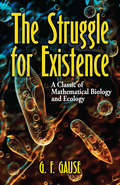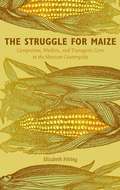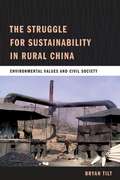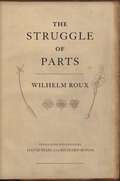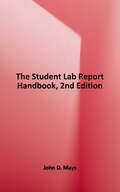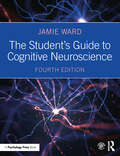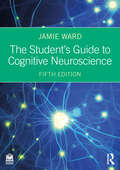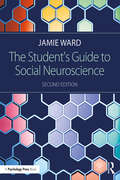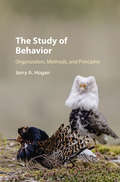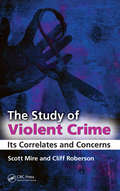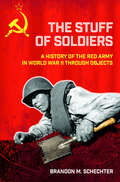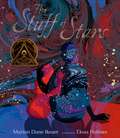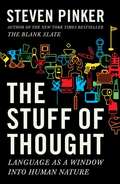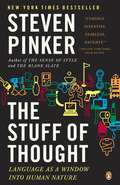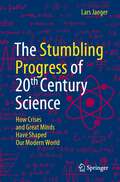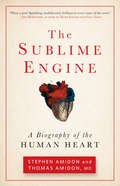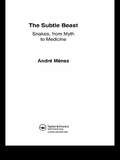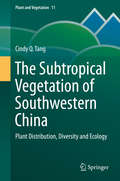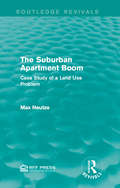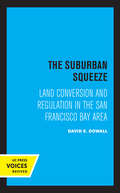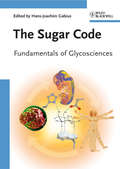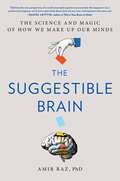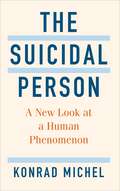- Table View
- List View
The Struggle for Existence: A Classic of Mathematical Biology and Ecology (Dover Books on Biology)
by G. F. GauseThis work by Russian microbiologist G. F. Gause broke ground for all subsequent research in the biomathematics of populations. Gause's work is essential in giving modern science its grasp of the complexities of population competition; it depicts a microcosm of the process at work on a larger scale throughout the biosphere, and it provides readers with the means for the process's quantitative evaluation. Starting with an exploration of the struggle for existence in nature, Gause summarizes the theoretical and experimental work that preceded his own. A discussion of the tools of mathematical biology follows, deriving formulas for the measurement of such basic concepts as potential population increase, population saturation, environmental resistance, and the intensity of the struggle for existence. Gause then reports in depth on his own experimental work and his conclusions: that the periodic expansions and contractions of populations are dependent upon the introduction of new variables and are not an inherent property of the predator-prey relationship. Easily understood by anyone acquainted with higher mathematics, this book constitutes essential reading for modern students of population dynamics.
The Struggle for Maize: Campesinos, Workers, and Transgenic Corn in the Mexican Countryside
by Elizabeth FittingWhen scientists discovered transgenes in local Mexican corn varieties in 2001, their findings intensified a debate about not only the import of genetically modified (GM) maize into Mexico but also the fate of the peasantry under neoliberal globalization. While the controversy initially focused on the extent to which gene flow from transgenic to local varieties threatens maize biodiversity, anti-GM activists emphasized the cultural significance of the crop in Mexico and demanded that campesinos and consumers have a voice in the creation of GM maize and rural policies. In The Struggle for Maize, Elizabeth Fitting explores the competing claims of the GM corn debate in relation to the livelihood struggles of small-scale maize producers, migrants, and maquiladora workers from the southern Tehuacn Valley. She argues that the region's biodiversity is affected by state policies that seek to transform campesinos into entrepreneurs and rural residents into transnational migrant laborers. While corn production and a campesino identity remain important to an older generation, younger residents have little knowledge of or interest in maize agriculture; they seek out wage labor in maquiladoras and the United States. Fitting's ethnography illustrates how agricultural producers and their families respond creatively to economic hardship and Mexico's "neoliberal corn regime," which promotes market liberalization, agricultural "efficiency," and the reduction of state services over domestic maize production and food sovereignty.
The Struggle for Sustainability in Rural China: Environmental Values and Civil Society
by Bryan TiltThough China's economy is projected to become the world's largest within the next twenty years, industrial pollution threatens both the health of the country's citizens and the natural resources on which their economy depends. Capturing the consequences of this reality, Bryan Tilt conducts an in-depth, ethnographic study of Futian Township, a rural community reeling from pollution. The industrial township is located in the populous southwestern province of Sichuan. Three local factories-a zinc smelter, a coking plant, and a coal-washing plant-produce air and water pollution that far exceeds the standards set by the World Health Organization and China's Ministry of Environmental Protection. Interviewing state and company officials, factory workers, farmers, and scientists, Tilt shows how residents cope with this pollution and how they view its effects on health and economic growth. Striking at the heart of the community's environmental values, he explores the intersection between civil society and environmental policy, weighing the tradeoffs between protection and economic growth. Tilt ultimately finds that the residents are quite concerned about pollution, and he investigates the various strategies they use to fight it. His study unravels the complexity of sustainable development within a rapidly changing nation.
The Struggle of Parts
by Wilhelm RouxA landmark work of nineteenth-century developmental and evolutionary biology that takes the Darwinian struggle for existence into the organism itself.Though he is remembered primarily as a pioneer of experimental embryology, Wilhelm Roux was also a groundbreaking evolutionary theorist. Years before his research on chicken and frog embryos cemented his legacy as an experimentalist, Roux endorsed the radical idea that a “struggle for existence” within organisms—between organs, tissues, cells, and even subcellular components—drives individual development.Convinced that external competition between individuals is inadequate to explain the exquisite functionality of bodily parts, Roux aimed to uncover the mechanistic principles underlying self-organization. The Struggle of Parts was his attempt to provide such a theory. Combining elements of Darwinian selection and Lamarckian inheritance of acquired characteristics, the work advanced a materialist explanation of how “purposiveness” within the organism arises as the body’s components compete for space and nourishment. The result, according to Charles Darwin, was “the most important book on evolution which has appeared for some time.”Translated into English for the first time by evolutionary biologist David Haig and Richard Bondi, The Struggle of Parts represents an important forgotten chapter in the history of developmental and evolutionary theory.
The Student Lab Report Handbook: A Guide to Content, Style, and Formatting for Effective Science Lab Reports
by John D. MaysThe Student Lab Report Handbook is a concise student resource to help learn how to prepare a premier lab report. Syntax, voice, tense, word choice, technical expression, data analysis, and error prediction are all discussed. This book is not specific to any discipline so it can be used with physics, biology, chemistry, or any other subject.
The Student's Guide to Cognitive Neuroscience
by Jamie WardReflecting recent changes in the way cognition and the brain are studied, this thoroughly updated fourth edition of this bestselling textbook provides a comprehensive and student-friendly guide to cognitive neuroscience. Jamie Ward provides an easy-to-follow introduction to neural structure and function, as well as all the key methods and procedures of cognitive neuroscience, with a view to helping students understand how they can be used to shed light on the neural basis of cognition. The book presents a comprehensive overview of the latest theories and findings in all the key topics in cognitive neuroscience, including vision, hearing, attention, memory, speech and language, numeracy, executive function, social and emotional behavior and developmental neuroscience. Throughout, case studies, newspaper reports, everyday examples and studentfriendly pedagogy are used to help students understand the more challenging ideas that underpin the subject. New to this edition: Increased focus on the impact of genetics on cognition New coverage of the cutting-edge field of connectomics Coverage of the latest research tools including tES and fNIRS and new methodologies such as multi-voxel pattern analysis in fMRI research Additional content is also included on network versus modular approaches, brain mechanisms of hand-eye coordination, neurobiological models of speech perception and production and recent models of anterior cingulate function. Written in an engaging style by a leading researcher in the field and presented in full color including numerous illustrative materials, this book will be invaluable as a core text for undergraduate modules in cognitive neuroscience. It can also be used as a key text on courses in cognition, cognitive neuropsychology, biopsychology or brain and behavior. Those embarking on research will find it an invaluable starting point and reference. This textbook is supported by an extensive companion website for students and instructors, including lectures by leading researchers, links to key studies and interviews, interactive multiple-choice questions and flashcards of key terms.
The Student's Guide to Cognitive Neuroscience
by Jamie WardReflecting recent changes in the way cognition and the brain are studied, this thoroughly updated fifth edition of this bestselling textbook provides a comprehensive and student-friendly guide to cognitive neuroscience. Jamie Ward provides an easy-to-follow introduction to neural structure and function, as well as all the key methods and procedures of cognitive neuroscience, with a view to helping students understand how they can be used to shed light on the neural basis of cognition.The book presents a comprehensive overview of the latest theories and findings in all the key topics in cognitive neuroscience, including vision, hearing, attention, memory, speech and language, executive function, social and emotional behavior, and developmental neuroscience. Throughout, case studies, newspaper reports, everyday examples, and student-friendly pedagogy are used to help students understand the more challenging ideas that underpin the subject. This edition features expanded coverage of consciousness, a combined chapter on literacy and numeracy, and increased coverage of brain networks and computational approaches.Written in an engaging style by a leading researcher in the field and presented in full color including numerous illustrative materials, this book will be invaluable as a core text for undergraduate modules in cognitive neuroscience. It can also be used as a key text on courses in cognition, cognitive neuropsychology, biopsychology, or brain and behavior. Those embarking on research will find it an invaluable starting point and reference.This textbook is supported by an extensive collection of free digital resources for students and instructors, including lectures by leading researchers, links to key studies and interviews, multiple-choice questions, and interactive flashcards to test your knowledge. Visit the Instructor & Student Resources website at routledgelearning.com/wardcognitiveneuroscience.
The Student's Guide to Social Neuroscience
by Jamie WardSocial neuroscience is a rapidly growing field which explains, using neural mechanisms, our ability to recognize, understand, and interact with others. Concepts such as trust, revenge, empathy, prejudice, and love are now being explored and unravelled by neuroscientists. This engaging and cutting-edge text provides an accessible introduction to the complex methods and concepts of social neuroscience, with examples from contemporary research and a blend of different pedagogical features helping students to engage with the material, including essay questions, summary and key points, and further reading suggestions. The second edition of this ground-breaking text has been thoroughly revised and expanded to reflect the growing volume of evidence and theories in the field.?Notable additions include a greater emphasis on genetics and hormones, and the expansion of topics such as cultural neuroscience, emotion regulation, biological markers of autism, power and status, social categorization, and new accounts of mirror neuron functioning. The book is supported by a fully updated companion website, featuring student resources including lecture recordings, multiple choice questions and useful web links, as well as PowerPoint slides for lecturers. Richly illustrated in attractive full-color, with figures, boxes, and ‘real-world’ implications of research, this text is the ideal introduction to the field for both undergraduate and postgraduate students in fields such as psychology and neuroscience.
The Study of Behavior: Organization, Methods, and Principles
by Jerry A. HoganBehavior studies now span a variety of sub-disciplines, including behavioral ecology, neuroscience, cognitive psychology and evolutionary developmental biology. While the fields' rapid growth has led to startling new insights into animal behavior, it has brought increasingly fragmented approaches to the subject. Integrating ideas and findings from a range of disciplines, this book provides a common framework for understanding diverse issues in behavior studies. The framework is derived from classical ethology, incorporating concepts and data from research in experimental psychology, neurophysiology and evolutionary biology. Hogan outlines the origin and development of major ideas and issues in the field, drawing on examples throughout to highlight connections across sub-disciplines. Demonstrating how results in one area can directly inform work in others, the book ultimately proposes concepts to facilitate new discussions that will open the way for improved dialog between researchers across behavior studies.
The Study of Violent Crime: Its Correlates and Concerns
by Cliff Roberson Scott MireViolence is a complex subject that is rooted in a multitude of disciplines, including not only criminology but also psychology, sociology, biology, and other social science disciplines. It is only through understanding violence as a concept that we can hope to respond to it appropriately and to prevent it. The Study of Violent Crime: Its Correlates
The Stuff of Soldiers: A History of the Red Army in World War II through Objects (Battlegrounds: Cornell Studies in Military History)
by Brandon M. SchechterThe Stuff of Soldiers uses everyday objects to tell the story of the Great Patriotic War as never before. Brandon Schechter attends to a diverse array of things—from spoons to tanks—to show how a wide array of citizens became soldiers, and how the provisioning of material goods separated soldiers from civilians.Through a fascinating examination of leaflets, proclamations, newspapers, manuals, letters to and from the front, diaries, and interviews, The Stuff of Soldiers reveals how the use of everyday items made it possible to wage war. The dazzling range of documents showcases ethnic diversity, women's particular problems at the front, and vivid descriptions of violence and looting.Each chapter features a series of related objects: weapons, uniforms, rations, and even the knick-knacks in a soldier's rucksack. These objects narrate the experience of people at war, illuminating the changes taking place in Soviet society over the course of the most destructive conflict in recorded history. Schechter argues that spoons, shovels, belts, and watches held as much meaning to the waging of war as guns and tanks. In The Stuff of Soldiers, he describes the transformative potential of material things to create a modern culture, citizen, and soldier during World War II.
The Stuff of Stars
by Marion Dane Bauer Ekua Holmes<p>In an astonishing unfurling of our universe, Newbery Honor winner Marion Dane Bauer and Caldecott Honor winner Ekua Holmes celebrate the birth of every child. <p>Before the universe was formed, before time and space existed, there was . . . nothing. But then . . . BANG! Stars caught fire and burned so long that they exploded, flinging stardust everywhere. And the ash of those stars turned into planets. Into our Earth. And into us. In a poetic text, Marion Dane Bauer takes readers from the trillionth of a second when our universe was born to the singularities that became each one of us, while vivid illustrations by Ekua Holmes capture the void before the Big Bang and the ensuing life that burst across galaxies. A seamless blend of science and art, this picture book reveals the composition of our world and beyond — and how we are all the stuff of stars.</p>
The Stuff of Thought: Language as a Window into Human Nature
by Steven PinkerThe author explains how the mind works by examining the way we use words. Pinker takes on scientific questions - such as how language affects thought, and which of our concepts are innate - as well as questions from the headlines and everyday life.
The Stuff of Thought: Language as a Window into Human Nature
by Steven PinkerThis New York Times bestseller is an exciting and fearless investigation of language Bestselling author Steven Pinker possesses that rare combination of scientific aptitude and verbal eloquence that enables him to provide lucid explanations of deep and powerful ideas. His previous books?including the Pulitzer Prize finalist The Blank Slate?have catapulted him into the limelight as one of today?s most important popular science writers. In The Stuff of Thought, Pinker presents a fascinating look at how our words explain our nature. Considering scientific questions with examples from everyday life, The Stuff of Thought is a brilliantly crafted and highly readable work that will appeal to fans of everything from The Selfish Gene and Blink to Eats, Shoots & Leaves.
The Stumbling Progress of 20th Century Science: How Crises and Great Minds Have Shaped Our Modern World
by Lars JaegerThe 70 years from 1880 to 1950 witnessed the final ascent of humankind into the modern age. Historically, this period is characterized by deep political, social and economic crises. However, parallel to this and much less known in the public, rational scientific thinking also experienced the darkest and deepest crisis of its own history. All the great modern scientific discoveries like quantum theory, genetics and neurology are products of this. Ground-breaking discoveries, profound crises, revolutionary thoughts, refutation of previously unshakable beliefs - these years are marked by scientific achievements of numerous great minds, who overturned our understanding of the world, of space, time and infinity, of life, logic and calculability almost overnight. The "intuitive genius" of these pioneers still forms the foundation of today’s scientific thinking and technological progress. In fact, tackling and overcoming those deep scientific crises shaped our modern life like nothing else. The resulting reorientation of our understanding of nature and ourselves allowed ancient philosophical questions to appear in a new light: "What is reality?", "What can we know about the world?" or "What is man's place in nature?". The most exciting period in the history of science is retold here in an entertaining way.
The Sublime Engine: A Biography of the Human Heart
by Stephen Amidon Thomas AmidonThe heart has consistently captured the human imagination. It has been singled out as a cultural icon, the repository of our deepest religious and artistic impulses, the organ whose steady functioning is understood, both literally and symbolically, as the very life force itself. The Sublime Engine will explore the profound sense of awe every person feels when they ponder the miracle encased within their ribs. In this lyrical history of our most essential organ, a critically-acclaimed novelist and a leading cardiologist--who happen to be brothers--draw upon history, science, religion, popular culture, and literature to illuminate all of the heart's physical and figurative chambers. Each of the four sections-- The Ancient Heart, The Renaissance Heart, The Modern Heart, and The Future Heart--will focus on a major epoch in our understanding of the heart and the hidden history of cardiology. Erudite, witty, and enthralling, The Sublime Engine makes the heart come alive for readers.
The Sublime in Antiquity
by James I. PorterCurrent understandings of the sublime are focused by a single word ('sublimity') and by a single author ('Longinus'). The sublime is not a word: it is a concept and an experience, or rather a whole range of ideas, meanings and experiences that are embedded in conceptual and experiential patterns. Once we train our sights on these patterns a radically different prospect on the sublime in antiquity comes to light, one that touches everything from its range of expressions to its dates of emergence, evolution, role in the cultures of antiquity as a whole, and later reception. This book is the first to outline an alternative account of the sublime in Greek and Roman poetry, philosophy, and the sciences, in addition to rhetoric and literary criticism. It offers new readings of Longinus without privileging him, but instead situates him within a much larger context of reflection on the sublime in antiquity.
The Subtle Beast: Snakes, From Myth to Medicine
by Andre MenezThe Subtle Beast: Snakes, from Myth to Medicine introduces you to the complex and absorbing world of these mysterious creatures. Each of the fourteen chapters in this volume can be read independently, but read together they trace a fascinating journey from the macroscopic features of snakes to the molecular description of their venom components. <B
The Subtropical Vegetation of Southwestern China
by Cindy Q. TangThis book provides a wealth of high-quality scientific information on the patterns and processes of vegetation change across a broad range of spatial and temporal scales, concentrating on Southwestern China, mostly on the Yunnan region, and extending to the Yangtze River valley near the boundaries separating Chongqing, Sichuan and Guizhou.
The Suburban Apartment Boom: Case Study of a Land Use Problem (Routledge Revivals)
by Max NeutzeWith an increase in urban crises arising from a growing population and rising affluence, and the inadequacy of conventional theories to predict the future states of the environment, Resources for the Future laid out a series of studies on the resource base of the urban environment. Originally published in 1968, this particular study examines the increase of apartment construction in the suburb including the extent of construction and the factors behind construction such as population demographics, highway construction and national and local land use policy. Neutze makes comparisons of U.S. metropolitan areas to draw conclusions on new policies which the government should consider in relation to the urban land market. This title will be of interest to students of Environmental Studies.
The Suburban Squeeze: Land Conversion and Regulation in the San Francisco Bay Area (California Series in Urban Development)
by David E. DowallThis title is part of UC Press's Voices Revived program, which commemorates University of California Press’s mission to seek out and cultivate the brightest minds and give them voice, reach, and impact. Drawing on a backlist dating to 1893, Voices Revived makes high-quality, peer-reviewed scholarship accessible once again using print-on-demand technology. This title was originally published in 1984.
The Sugar Code: Fundamentals of Glycosciences
by Hans-Joachim GabiusA reader friendly overview of the structure and functional relevance of natural glycosylation and its cognate proteins (lectins), this book is also one of the few books to cover their role in health and disease. Edited by one of the pioneering experts in the field and written by a team of renowned researchers this resource is a perfect introduction for all students in life and medical sciences, biochemistry, chemistry and pharmacy. Website: WWW.WILEY-VCH.DE/HOME/THESUGARCODE
The Suggestible Brain: The Science and Magic of How We Make Up Our Minds
by Amir RazNeuroscientist Amir Raz shares decades of research and case studies to show how suggestion changes the brain and shapes our behavior—and how we can protect ourselves from and harness suggestibility in our own lives. Suggestions can make cheap wine taste like Château Margaux, warp our perception of time, and alter our memories—and in an age where disinformation has impacted our personal lives and our politics, the power of suggestion is worth even more attention. In The Suggestible Brain, world-renowned expert on the science of suggestion Amir Raz, PhD, brings together cognitive aspects of psychology, sociology, and anthropology with issues in our contemporary culture, media, alongside a series of case studies of patients with disorders ranging from Tourette&’s Syndrome to false pregnancies, lactose intolerance, and asthma to show exactly how suggestions can cut deep into our brains, shake our fundamental knowledge, and override our core human values. Some questions include: Why do placebos work even when people know they are inactive pills—and why do red pills cause stress whereas blue pills feel calm? Can suggestions effectively treat depression and anxiety? How do people weaponize suggestion in the form of gaslighting and mental abuse? Why are we more likely to believe fake news that already aligns with our political beliefs? How can suggestions help fight racism, hatred, and bigotry? Conversely, how can suggestions backfire and create the opposite effect? Merging Dr. Raz&’s experiences as a magician and hypnotist with decades&’ worth of his own neuropsychological research, The Suggestible Brain maps the twilight zone where magic and science coalesce, and shows how easily suggestible and manipulable we all are. Readers will walk away with actionable advice on how to harness the science of suggestion to propel change, protect against manipulative misinformation, and better regulate our internal, mental universe.&“Professor Amir Raz is a consummate scientist and former professional magician. His scientific research and writing have made substantial contributions to our understanding of hypnosis, placebo effects, and suggestion. His book will amaze and entertain you, while at the same time being firmly rooted in the scientific data. It is a magical book.&”--Irving Kirsch, PhD, author of The Emperor&’s New Drugs: Exploding the Antidepressant Myth"[This book] could have been titled This is Your Brain on Magic. Told from the twin perspectives of a world-renowned cognitive neuroscientist who happens to be a professional magician, you&’ll never again think about what you see, hear, and experience the same way.&”—Daniel Levitan, author of This is Your Brain on Music
The Suicidal Person: A New Look at a Human Phenomenon
by Konrad MichelKonrad Michel, a leading psychiatrist and acclaimed expert, draws on decades of experience to offer necessary new ways of understanding—and preventing—suicide. After one of his first patients died by suicide, Michel devoted himself to researching self-harm. Writing vividly and personally, he recounts more than forty years of working with and learning from suicidal patients.Michel shows that suicide is not just a consequence of mental illness but an action related to a person’s life story. Drawing on hundreds of interviews with suicidal patients, he argues that suicide and suicide attempts occur when someone experiences extreme emotional pain that severely impairs the ability to think and act rationally. Based on this understanding, Michel and his colleagues developed a person-centered approach to treatment that overcomes the limitations of the traditional medical model. Through a brief therapy, patients find a personally meaningful narrative understanding of their suicidal thoughts and impulses. People at risk can learn to recognize their vulnerabilities in order to manage potentially life-threatening situations and keep themselves safe. Michel emphasizes the importance of communication: medical professionals need to connect with patients as individuals to identify specific warning signs.Both compassionate and rigorous, this book provides vital insight into suicide prevention and shows how changing attitudes will help save lives. It includes practical advice for people at risk, with special emphasis on young people, as well as for relatives and health professionals.
